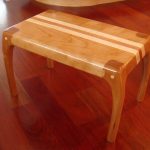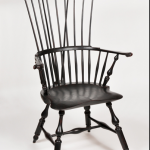We may receive a commission when you use our affiliate links. However, this does not impact our recommendations.
As managing editor, one of my duties is to pull together the “Letters” column for each issue, so please send in your questions or comments for me, the other editors or even for magazine contributors. We’ll do our best to provide answers as soon as we can.
 As I worked on the upcoming August issue, a letter popped up about Peter Franks’ footstool from the End Grain column (“A Woodworking Disorder”) in the April 2013 magazine (issue #203). A reader, Rey James, wanted to know more about the footstool. He had an idea as to the joinery, but given the angle of the photo, he was unsure. And here is the best part. James asked for more information “… if Franks was willing to reveal his secrets.”
As I worked on the upcoming August issue, a letter popped up about Peter Franks’ footstool from the End Grain column (“A Woodworking Disorder”) in the April 2013 magazine (issue #203). A reader, Rey James, wanted to know more about the footstool. He had an idea as to the joinery, but given the angle of the photo, he was unsure. And here is the best part. James asked for more information “… if Franks was willing to reveal his secrets.”
Mr. Franks was only too happy to reveal his secrets for the Maloof-style joint. And that’s what makes woodworking so great. Everyone should share their techniques. Reveal their secrets. That makes woodworking better.
Here is Mr. Franks’ reply: Rather than repeating everything here, I’ll send you to a forum I moderate, called talkFestool.com. Below is a link to a thread I started (I post as “Poto”) showing how to do that joint. In this case it’s on a table, but the footstool is identical – just a smaller piece of wood.
Cheers, Peter
And while you’re there, wander around the forum. There is a lot of good advice and information posted. And if you’re interested in more Maloof-style joinery, take a look at Build A Sculptured Rocker with Charles Brock – Super Rocker Bundle that includes two DVDs, a book, full-size patterns and online support from the author.
Here are some supplies and tools we find essential in our everyday work around the shop. We may receive a commission from sales referred by our links; however, we have carefully selected these products for their usefulness and quality.









I hope this is a good place to post this. This letter is for Megan…My Heroine! Your blanket chest in the August issue is a beautiful combination of wood selection and matching, design (simple is good!), and execution. I have enjoyed watching you grow your woodworking skills. You are an inspiration to me and I’m sure to other lonely women and girls out there in the mostly male world of woodworking.
I especially love this issue, with its range of projects. I plan to make a modified form of the book stand, sans the turnings, since I don’t own a lathe.
Again, Megan, brava!
Mary Kathryn Vernon
I just received my August issue and couldn’t put it down till I read it for the first of many times. I was reading the “Letters” article and you answered the question from Joe Scanlon about the two methods you use to square the ends of a board. Joe stated the board length was 70 inches. Even though the edges were parallel, after he ripped them did they end up developing a curve in the edge of the board? Even if the edges are parallel, if the board is curved the ends will never be square with each other. They will be square at each end, but not always with the other end. An amendment to your answer is needed to have Joe check that the edges are straight over the 70 inch length. I really think this is where his problem lies. Don’t you agree?
Thank you Glen (and Mr. Franks), surprising how sometimes people feel proprietary about techniques. I wish I had seen this post before, it took me a while (and a few pieces of wood) to figure out all I needed was a round over bit for the legs.
In the absence of a round over bit, a profile made with some 1/4″ MDF, a pairing chisel and a lot of patience can give the same results. To smooth the curve I used cloth backed sanding paper and sort of “polish” like one does when polishing shoe shine. It worked perfectly.
It is also refered to as a hip joint.